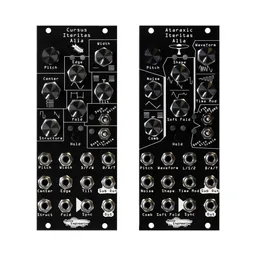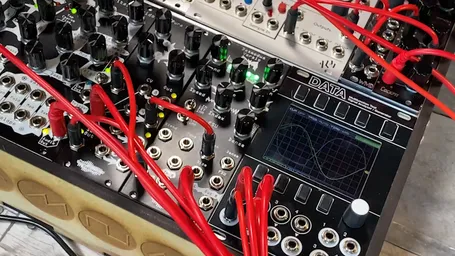Sync: it’s a common feature on oscillators, but what does it actually do?
A lot of things, and it depends, are the two answers to that question! In this post, we’ll talk about the two most common types of sync, how we implement it in our oscillators, and some fun and creative uses for sync. Let’s dive in.
Sync: the basics
In general, sync resets an oscillator to a particular position when a signal above a threshold is received at the sync input. Sometimes, it also does other things. We’ll talk about all of this in this post, because it’s weird. In general, sync is used with two oscillators working together: one is the “master” oscillator, and one is the “slave” oscillator, which is synced to the master. Syncing is done in this context by patching (internally or externally) an oscillator’s output to the sync input on another oscillator.
Note: some oscillators will sync to pretty much anything, but in general, it’s your best bet to use a triangle wave as your sync source.
There’s a bunch of different types of sync, and there’s not names for all of them, and some different ones use the same name, because why not
Sync basically never does the same thing across different oscillators. In this post, we’ll talk about the most common types, and what our oscillators do, but if you’re curious about a particular oscillator, you’ll probably have to ask.
Learn more:
Hard sync
This is probably the most common type of sync. Every time a sync input signal breaks the threshold, the waveform on the sync’d oscillator resets to the beginning. If the oscillators are different frequencies, you get some interesting overtones, and the root frequency sounds the same. It’s one of my favorite traditional synth sounds, and it looks like this:

Hard sync visualized.
Soft sync
Soft sync can do a few different things. Because why would there be different names for different things? Since there are so many options, I’ll go over the one I see the most. Again, your oscillator may do something different, so it’s worth looking at the manual of your module or synth. The most common type of soft sync is phase-reverse soft sync, which resets the oscillator position when a sync signal breaks the threshold but also reverses the direction of the waveform. This one is a bit more tricky to visualize, but it looks like this:

Soft sync: it’s funky lookin’.
Note that, sometimes, people have called this hard sync, too. Why? Couldn't tell you.
NE sync
Of course, it wouldn’t be a Noise Engineering oscillator if we didn’t do sync a weird way, would it? We use hard sync on all of our oscillators with sync input (and, actually, the MI and BIA, too). Some of our oscillators, like the Ataraxic Iteritas, also phase-invert whenever they get a sync signal, too. This makes for some interesting results sonically, and looks funky:

The way we sometimes do sync here at NE.
Fun fact: BIA does this if you trigger it at audio rates. Get your scope out and send it some fast triggers, you’ll get some interesting results…
In use
Sync is a great technique when creating subtractive patches with multiple oscillators. I particularly like the sounds of the sync on the Rossum Trident and the Doepfer A-111-2 (since there are so many ways of doing sync, different oscillators tend to sound a bit different even when doing the same thing). Sync a couple of oscillators together, patch them into a mixer, then through a filter for a thick-sounding subtractive voice. You can also do interesting things like modulate the frequency of the slave oscillator to create timbral changes without actually changing the pitch of the sound.
Uses outside of syncing two oscillators together
Having an oscillator always start at the same point in a cycle can be helpful. This actually goes back to the Minimoog; every time a key was pressed the oscillators would reset. This can be achieved easily by sending a trigger or gate to the hard sync input on an oscillator. I use this technique a lot, especially when synthesizing things like percussion sounds.
Let’s hear what this actually sounds like
Here, I’m using two Loquelic Iteritas synced together into a mixer, then run through Viol Ruina as a filter, then through Seca Ruina as a VCA. I’m sequencing the pitches of the oscillators separately to get extreme timbral changes on the slave oscillator.
In conclusion
Since sync is such a badly-defined concept, it will always be beneficial to just try things out and see how they sound. Experimentation always leads to new discoveries, especially in modular, so see what you can come up with! If you make a cool patch, make sure you tag us on Instagram or send it to us via the contact page.






